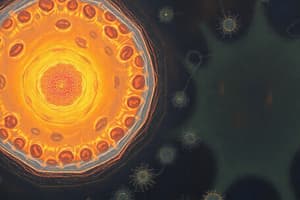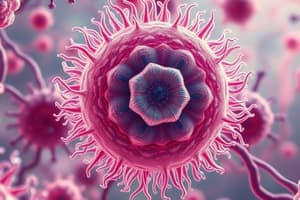Podcast
Questions and Answers
¿Cuál es el principal resultado de la mitosis?
¿Cuál es el principal resultado de la mitosis?
- Producción de dos células hijas idénticas (correct)
- Producción de células especializadas
- Producción de gametos
- Conversión de energía luminosa en energía química
¿Qué describe mejor la especialización celular?
¿Qué describe mejor la especialización celular?
- El proceso de reproducción celular
- La adquisición de funciones específicas en células (correct)
- La división de células en gametos
- La conversión de energía en compuestos químicos
¿Cuál de las siguientes afirmaciones sobre la comunicación celular es correcta?
¿Cuál de las siguientes afirmaciones sobre la comunicación celular es correcta?
- La comunicación celular ocurre exclusivamente a través de señales eléctricas.
- El ADN es el principal mensajero químico en la comunicación celular.
- Las hormonas son mensajeros químicos que facilitan la comunicación entre células. (correct)
- Las células no necesitan comunicarse entre sí.
¿Qué proceso implica la transcripción de ADN a ARN?
¿Qué proceso implica la transcripción de ADN a ARN?
¿Qué es la diferenciación celular?
¿Qué es la diferenciación celular?
¿Cuál de las siguientes estructuras es característica de las células procariotas?
¿Cuál de las siguientes estructuras es característica de las células procariotas?
¿Qué orgánulo celular es responsable de la producción de energía en las células eucariotas?
¿Qué orgánulo celular es responsable de la producción de energía en las células eucariotas?
¿Cuál es la función principal de la membrana celular?
¿Cuál es la función principal de la membrana celular?
¿Qué tipo de células carecen de un núcleo?
¿Qué tipo de células carecen de un núcleo?
La función principal de los ribosomas en las células es:
La función principal de los ribosomas en las células es:
¿Cuál estructura se encuentra únicamente en las células vegetales?
¿Cuál estructura se encuentra únicamente en las células vegetales?
¿Qué función tiene el aparato de Golgi en la célula eucariota?
¿Qué función tiene el aparato de Golgi en la célula eucariota?
¿Qué componente de la membrana celular regula el transporte de moléculas?
¿Qué componente de la membrana celular regula el transporte de moléculas?
Flashcards
Fotosíntesis
Fotosíntesis
Proceso por el cual las células vegetales convierten la energía lumínica en energía química (glucosa).
División celular
División celular
Proceso crucial para el crecimiento y la reparación de los organismos.
Mitosis
Mitosis
Proceso de división nuclear que produce dos células hijas idénticas.
Meiosis
Meiosis
Signup and view all the flashcards
Síntesis de proteínas
Síntesis de proteínas
Signup and view all the flashcards
Célula
Célula
Signup and view all the flashcards
Células procariotas
Células procariotas
Signup and view all the flashcards
Células eucariotas
Células eucariotas
Signup and view all the flashcards
Pared celular (procariota)
Pared celular (procariota)
Signup and view all the flashcards
Membrana celular
Membrana celular
Signup and view all the flashcards
Citoplasma
Citoplasma
Signup and view all the flashcards
Mitocondrias
Mitocondrias
Signup and view all the flashcards
Retículo endoplásmico (RE)
Retículo endoplásmico (RE)
Signup and view all the flashcards
Study Notes
Introduction to the Cell
- The cell is the fundamental unit of life. All living organisms are composed of cells.
- Cells exhibit variations in size and shape, yet all share fundamental characteristics.
- Cells perform essential life processes, encompassing metabolism, reproduction, and responses to stimuli.
Types of Cells
- Cells are broadly categorized into prokaryotic and eukaryotic types.
- Prokaryotic cells are simpler, smaller, and lack a nucleus and membrane-bound organelles. Examples include bacteria and archaea.
- Eukaryotic cells are more complex, larger, and possess a nucleus and membrane-bound organelles. Examples encompass plant and animal cells.
Prokaryotic Cell Structures
- Prokaryotic cells typically possess a cell wall, cell membrane, cytoplasm, ribosomes, and a nucleoid region.
- The cell wall provides structural support and protection.
- The cell membrane regulates the passage of materials into and out of the cell.
- Cytoplasm is the gel-like substance filling the cell.
- Ribosomes are responsible for protein synthesis.
- The nucleoid region contains the genetic material (DNA).
Eukaryotic Cell Structures
- Eukaryotic cells contain a nucleus and various membrane-bound organelles.
- The nucleus houses the cell's genetic material (DNA).
- Mitochondria, the powerhouses of the cell, are responsible for energy production (ATP).
- Ribosomes are present in eukaryotic cells, playing a crucial role in protein synthesis.
- Endoplasmic reticulum (ER) is a network of membranes involved in protein and lipid synthesis.
- The Golgi apparatus modifies, sorts, and packages proteins.
- Lysosomes contain enzymes for breaking down waste materials and cellular debris.
- Vacuoles store water, nutrients, and waste products.
- Chloroplasts are found in plant cells and are involved in photosynthesis.
- The cytoskeleton provides structural support and aids cell movement.
Cell Membrane
- The cell membrane is a selectively permeable barrier controlling the passage of substances into and out of the cell.
- It primarily consists of phospholipids and proteins.
- The phospholipid bilayer forms the membrane's basic structure, with hydrophobic tails facing inward and hydrophilic heads facing outward.
- Embedded proteins perform various functions, including molecule transport and cell signaling.
Cell Processes
- Cellular respiration is the process by which cells break down glucose to produce energy.
- Photosynthesis is a process used by plant cells to convert light energy into chemical energy (glucose).
- Cell division is crucial for growth and repair.
- Mitosis is the process of nuclear division, producing two identical daughter cells.
- Meiosis is a type of cell division that creates gametes (sex cells).
- Protein synthesis involves transcribing DNA into RNA and translating RNA into protein.
Cell Specialization
- Cells specialize to perform distinct functions in multicellular organisms.
- Specialized cells often form tissues, organs, and organ systems.
- Examples of specialized cells include nerve cells (neurons), muscle cells, and epithelial cells.
Cellular Communication
- Cells communicate with one another through various mechanisms, like chemical signaling.
- Cell signaling pathways regulate cellular activities and responses.
- Hormones are important chemical messengers facilitating communication between cells.
Cell Differentiation
- Cell differentiation is the process where a less specialized cell becomes a more specialized cell.
- This process is critical for the development of multicellular organisms and involves changes in gene expression.
Studying That Suits You
Use AI to generate personalized quizzes and flashcards to suit your learning preferences.




